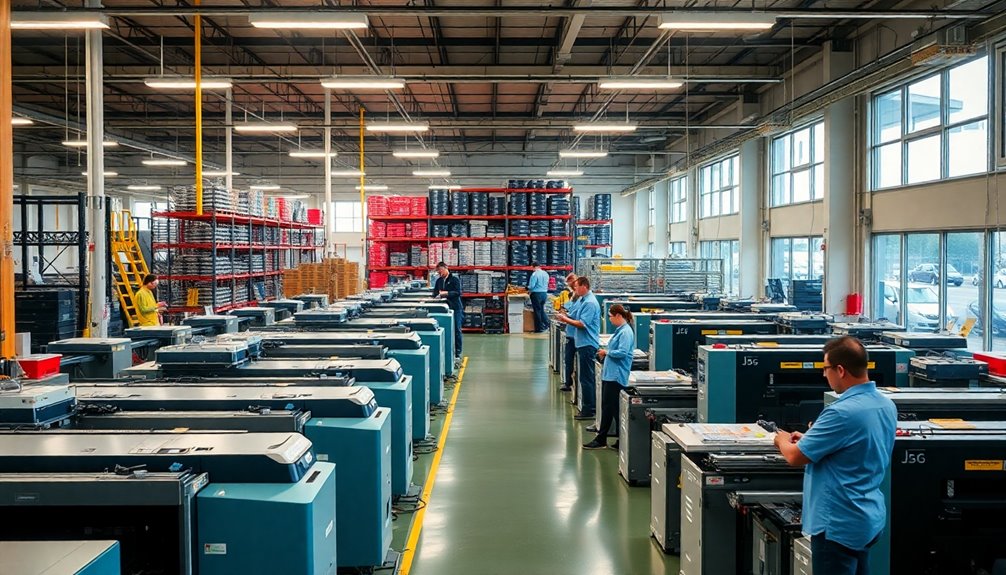When comparing cotton paper to cellulose-based paper, you’ll find that cotton paper is more durable, resistant to aging, and environmentally friendly, especially if sustainably sourced. It’s made from stronger fibers, making it ideal for archival, artwork, and valuable documents. Cellulose paper, often derived from wood pulp, can be cheaper but tends to yellow, crack, and degrade faster over time, especially if not properly treated. To discover more about their environmental impacts and best uses, keep exploring these differences.
Key Takeaways
- Cotton paper is more durable, resistant to aging and wear, making it ideal for archival and artistic use.
- Cellulose-based paper is generally less durable but more cost-effective and suitable for everyday printing.
- Cotton paper has a lower environmental impact when sustainably sourced, especially if made from recycled textiles.
- Cellulose paper production involves deforestation and chemical processes, raising environmental concerns.
- For long-term preservation and eco-conscious choices, cotton paper is preferable due to its strength and biodegradability.

When choosing between cotton paper and cellulose-based paper, understanding their fundamental differences can help you make an informed decision. Both types of paper serve various purposes, but they differ markedly in terms of environmental impact and durability factors. Cotton paper is made primarily from cotton linters or rag fibers, which are often recycled textiles. Because of this, it tends to have a lower environmental footprint during production, especially if sourced sustainably. Cotton fibers are biodegradable and require less chemical processing, making cotton paper a more eco-friendly option for those concerned about environmental impact. In addition, cotton paper’s resistance to aging makes it ideal for archival use. In contrast, cellulose-based paper is derived from wood pulp, which involves cutting down trees and often uses chemical processes like bleaching. These procedures can have a more substantial environmental impact, leading to concerns about deforestation, water pollution, and chemical waste. If sustainability is a priority for you, cotton paper generally aligns better with eco-conscious choices, especially when sourced from responsibly managed forests or recycled textiles.
Durability factors are another vital aspect to consider. Cotton paper is renowned for its strength and resistance to wear and aging. Its fibers are longer and more resilient than those in cellulose paper, making it less prone to tearing or deterioration over time. This durability makes cotton paper ideal for archival purposes, fine art, and high-quality stationery that needs to last decades without significant degradation. Cellulose-based paper, while suitable for everyday printing and reading, tends to be less durable. It can become brittle, yellow, or develop acid-related deterioration as it ages, especially if not acid-free. However, advancements in manufacturing have improved the longevity of some cellulose papers, particularly those treated with lignin-free and acid-free processes. Still, in terms of long-term preservation, cotton paper generally outperforms cellulose-based options.
Choosing the right paper depends on your specific needs. If you’re seeking a sustainable, environmentally friendly option that offers excellent durability for valuable documents or artwork, cotton paper is a compelling choice. It combines eco-conscious production with longevity, helping your projects stand the test of time. Conversely, if you prioritize cost-effectiveness and are using paper for everyday tasks, cellulose-based paper may suffice, provided you select high-quality, acid-free varieties to enhance durability. Additionally, the recyclability of cellulose paper can be a deciding factor for eco-conscious consumers. Ultimately, weighing the environmental impact against durability factors will guide you to the best decision for your particular application. Both types have their strengths, but understanding these fundamental differences ensures you choose the right paper for your needs.
Frequently Asked Questions
How Does the Environmental Impact Differ Between Cotton and Cellulose-Based Paper?
You’ll find that cotton paper has a more sustainable sourcing process, often using recycled textiles, but it requires more water and energy to produce. Cellulose-based paper, made from wood pulp, can be more biodegradable but may involve deforestation and chemical treatments. Overall, cotton paper’s biodegradability differences make it eco-friendlier, but consider the environmental costs of sourcing and manufacturing for both options to make a responsible choice.
Which Paper Type Offers Better Archival Qualities?
You’ll find cotton paper offers superior archival longevity because of its material stability. Its higher natural fiber content resists aging and deterioration over time, making it ideal for preserving important documents or artwork. Cellulose-based paper, while more affordable, tends to break down faster and is less stable long-term. So, if longevity and stability are your priorities, cotton paper clearly provides better archival qualities.
Are There Cost Differences Between Cotton and Cellulose-Based Papers?
They say “you get what you pay for,” and with paper, pricing differences reflect manufacturing costs. Cotton paper generally costs more because its raw materials and production process are more expensive, making it pricier than cellulose-based paper. If you’re on a tight budget, cellulose paper offers a more affordable option. However, if durability and archival quality matter, investing in cotton paper might be worth the extra expense.
Can Cotton Paper Be Recycled as Easily as Cellulose-Based Paper?
You can recycle cotton paper as easily as cellulose-based paper because both undergo similar recycling processes. Cotton paper’s fibers are durable, allowing it to be reused multiple times, though it may require slightly more effort in sorting and processing. Manufacturing costs for recycling cotton tend to be higher due to the specialized handling needed, but overall, both types of paper are recyclable through standard paper recycling systems.
How Do Durability and Tear Resistance Compare Between the Two Types?
You’ll find that cotton paper generally offers higher fiber strength and better material flexibility compared to cellulose-based paper. This means it’s more durable and resistant to tearing, making it ideal for artworks or documents needing longevity. Cellulose paper, while still reasonably tear-resistant, tends to be less flexible and more prone to damage over time. So, if durability and tear resistance matter most, cotton paper is your better choice.
Conclusion
When choosing between cotton paper and cellulose-based paper, consider their unique qualities. Cotton paper, known for its durability, is often used for valuable documents, while cellulose-based paper is more common and affordable. Notably, over 90% of everyday paper is cellulose-based, highlighting its widespread use. So, whether you prioritize longevity or cost, understanding these differences helps you make smarter choices for your printing or art needs.









